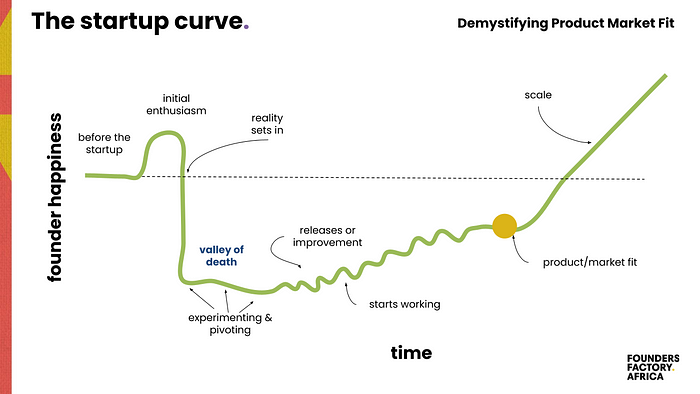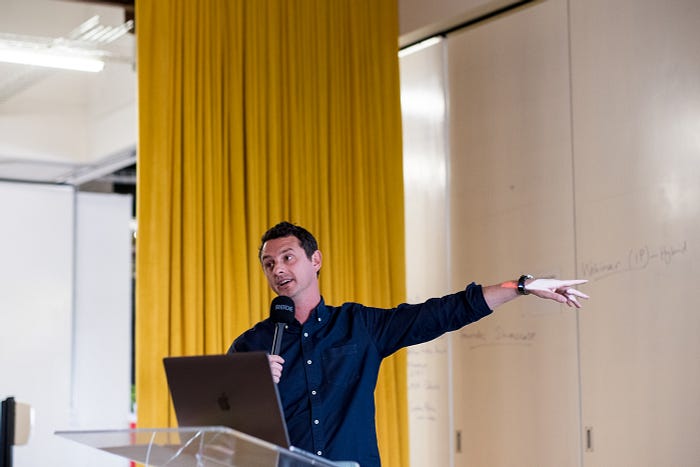Startup success hinges on achieving Product-Market Fit and delivering on customer value focus. It’s one of, if not the most, critical soft skills a startup founder needs to master.
Without a firm grasp of Product-Market Fit and acute customer value, founders and their teams risk squandering precious resources and time on endeavors that might not significantly impact the viability of their venture.
According to Steve Waidelich, and many others within the tech ecosystem, there is only one thing founders should focus on: duct market fit (PMF).
“We are often shocked by how many founders lose sight of the most important thing they should be trying to do. Founders focus on what their logo looks like or their office space or their website or the latest conference or their business cards, any kind of distraction apart from the most important thing. That is building a solution that meets their customer’s needs,” Waidelich, Head of Growth at Founders Factory Africa, told a group of early-stage founders on Wednesday, 4 October.
He was speaking at The Path to Product Market Fit: A Founder’s Toolbox to Scaling Success event, co-hosted by Founders Factory Africa and Google Cloud for Startups at Founders Factory Africa’s Johannesburg office.
Quoting Marc Andreessen, the founder of venture capital firm Andreessen Horowitz, Waidelich told the audience, “For new startups, the only thing that matters is getting to product market fit.”
PMF is so vital to a startup’s future, as Waidelich explained as he walked the audience through Paul Graham’s now canon-like Startup Curve, “Product market fit is this incredible inflexion point for your business.”

“What we have discovered at Founders Factory Africa is that many founders are focused on generating scale, increasing revenue, and growing their customer base. They think they should be raising more venture capital to fund scale, and many venture builders are focused on helping founders at that point,” Waidelich said, pointing at ‘scale’.
“Even investors are pushing founders towards the scale trajectory when actually this here, the path to scale, is littered with the gravestones of endless startups that didn’t fund product market fit and ran out of many. We see far too much attention on the ‘scale’ part and not enough tangible frameworks, actions, and tools to navigate this precious path.”
Defining PMF and How Operators Have Changed VC
While the importance of PMF within the ecosystem is understood, its definition is contested. Waidelich told the audience that “there is little content and material describing what product market fit is.”
“At Founders Factory Africa, we believe the narrative around PMF has evolved. There are a number of factors that contributed to the definition of PMF. I put a lot of emphasis on ex-operators-turned-investors, like Allan Chan, former Head of Growth at Uber and now a partner at Andreessen Horowitz,” Waidelich said.
“It was these operators that understood the nuances of product market fit, who knew how hard it is to find product market fit and the timely signals that they are able to identify building businesses. They have evolved the narrative to be more definitive and concrete, embedding how important metrics and quantitative measures are.”
In Waidelich’s view, PMF is about finding a level of satisfaction measured through retention that will drive customer retention. Where PMF is concerned, retention is its “ultimate measure” since it shows that a founder is building something customers love to use every day.

Metrics to measure and plot Product-Market Fit success
While retention is a vital measure of PMF, as described by Waidelich, it was but one of three ways to measure PMF success. From Founders Factory Africa’s point of view, a combination of these three metrics or “key measures” shines a light on how close founders are to attaining PMF. In addition to retention, Waidelich listed acquisition/growth and active usage + engagement as measures that provide “evidence” of PMF.
“Acquisition/growth is a really interesting signal of PMF. We like to call it the ‘magic’ metric because a metric like organic acquisition, for example, if you are getting more than 60% of new users getting on your platform, it means that your platform has some kind of natural pull or value that is pulling them to your products,” he said.
“Another factor is your viral factor or viral coefficient. If you have users telling other users about the platform, that is another quality signal. If you have a viral coefficient of more than 0.5 — one current user is helping you to acquire ‘half a person’ — that is a good magic metric or natural indicator that people using your product want to tell others about it.”
As Waidelich went into more detail about each measure, he stressed that the combination used on each startup differs and that founders applying the measure should do so in such a way that it acknowledges their startup’s particular market, service, product, and operating model.
The theory of Product-Market Fit is linear but in practice, it’s messy
In wrapping up his presentation, which also covered the different stages of PMF and Founders Factory Africa’s Traction Framework, Waidelich noted that while the frameworks he’d presented were linear, neat, and orderly, in practice, finding PMF is “messy and highly iterative”.
“The touchstone will always be your metrics so you can navigate the PMF maze into a structured, step-by-step process,” Waidelich said. “The number one superpower of world-class founders is the ability to focus. Too many founders get distracted and forget about building value for their customers. Build value for customers and focus on finding product-market fit.”






